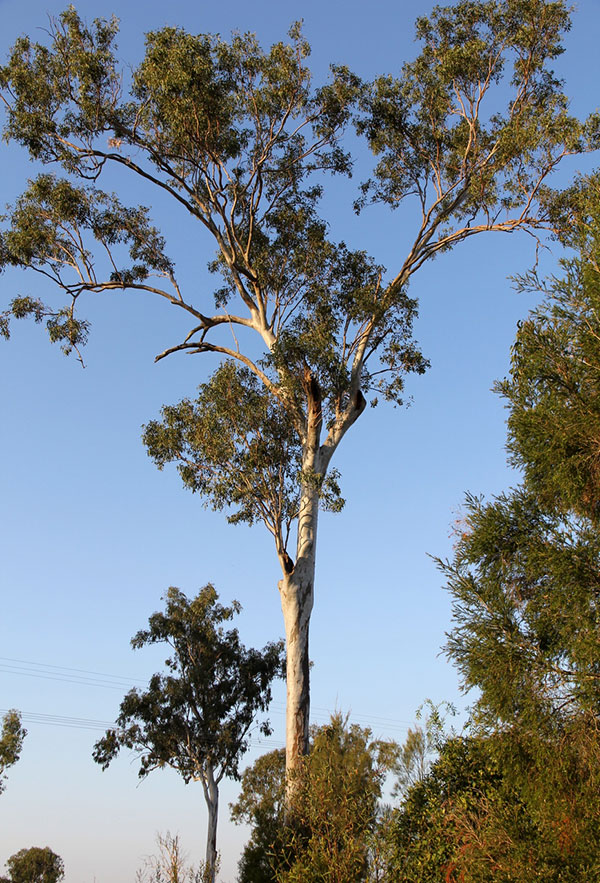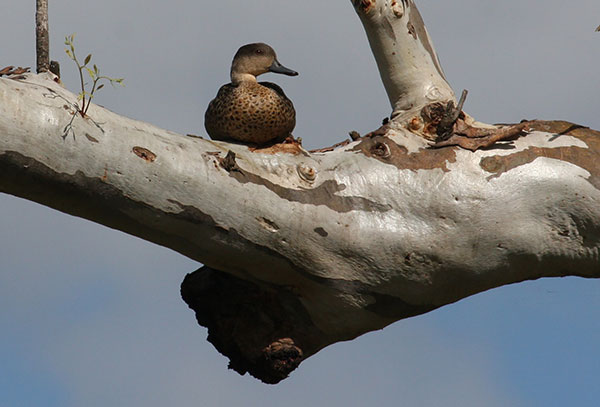When shopping for a new residence 27 years ago we immediately snapped up our current home, mainly because of the 40 mature Queensland Blue Gums (Eucalyptus tereticornis) growing on the block. All of these trees were in excess of 100 years old. The largest may have been growing here when James Cook sailed down the coast.
To give a single tree its worth, let’s look at a single 40 metre specimen in the front yard. This spreading tree has lost a few of its larger branches to thunder storms but still maintains a decent sized canopy shading an understorey of Black Tea-tree (Melaleuca bracteata), Boobialla (Myoporum montanum) and River She-oak (Casuarina cunninghamiana).
Like all of the eucalypts in our local area, this tree has been hollowed by the activity of termites during its century-plus life span. When a branch breaks during a storm, it opens up access to the hollow trunk. Invariably, the hollows are taken up by various forms of life for either shelter or nesting. Competition for nest sites in late winter and spring can be intense.
At this very minute (early-October) this single tree has nesting in various hollows the following birds: Sulphur-crested Cockatoos, Galahs, Rainbow Lorikeets, Scaly-breasted Lorikeets, Red-rumped Parrots, Dollarbirds, Nankeen Kestrels and pardalotes. Figbirds, Crested Pigeons and Rufous Whistlers are raising chicks in constructed nests high in the branches.


(Left:) The subject of these observations -a single, centenarian Queensland Blue Gum.
(Above:) A male Grey Teal in repose above the entrance to the pair’s nest hollow.
In the Black Tea-tree against the trunk of the gum are nests of Bar- shouldered Doves and Double-barred Finches.
In addition to the birdlife, there is a family of Common Brush-tailed Possums calling this tree home along with a cloud of Gould’s Wattle Bats and a hive of stingless native bees.
That is just the wildlife currently residing in this single blue gum. Broadening our view to those species finding food in the tree at the moment will see six species of honeyeaters, Olive-backed Orioles, White- winged Trillers, Red-backed Fairy-wrens, Restless Flycatchers, Grey Fantails, Willie Wagtails, Black-faced Cuckoo-shrikes, Little Bronze Cuckoos, Grey-crowned Babblers, Yellow-rumped Thornbills, Grey- headed and Little Red Flying Foxes, Carpet Pythons, Green Tree Snakes, a large skink species yet to be positively identified, Red-tailed Skinks, and this week, a Koala.
During the course of year, nesting hollows are also utilised by Pacific Black, Wood and Grey Teal ducks along with Cotton Pygmy Geese, Pale-headed Rosellas, Cockatiels, Little Corellas, Southern Boobooks, Laughing Kookaburras, Sacred Kingfishers and Barn Owls.
Wagtails, mudlarks, magpies, Brown Falcons, Hobbies, Black-shouldered Kites, thornbills and Ground Cuckoo-shrikes have all use the tree as a platform for their nests during the past couple of years.
Today, this one tree has fifteen species of large fauna as permanent residents. A further 22 species find food within its canopy.
It is only these long-lived trees that provide nest hollows for so many of our local species of wildlife. On our little 5.5 hectare block we have positively identified 35 species of native bird nesting in mature eucalypts. Twenty two of those, ranging from tiny Striated Pardalotes and Sacred Kingfishers up to stately Barn Owls and raucous Sulphur-crested Cockatoos, rely on hollows for nest sites.
It takes approximately 100 years for a eucalypt to be mature enough to provide the large hollows required by many of our native fauna. Trees of that vintage have a significant environmental value and cannot be replaced within our lifetime.
Even a dead tree containing hollows is a treasure. So many of these are being lost to the firewood industry, burned by well meaning folk who mistakenly believe burning wood to heat their homes is environmentally friendly.
So what is the value of one tree? Priceless!
Article and photos by Neil Schultz Land for Wildlife member Mount Tarampa, Somerset
